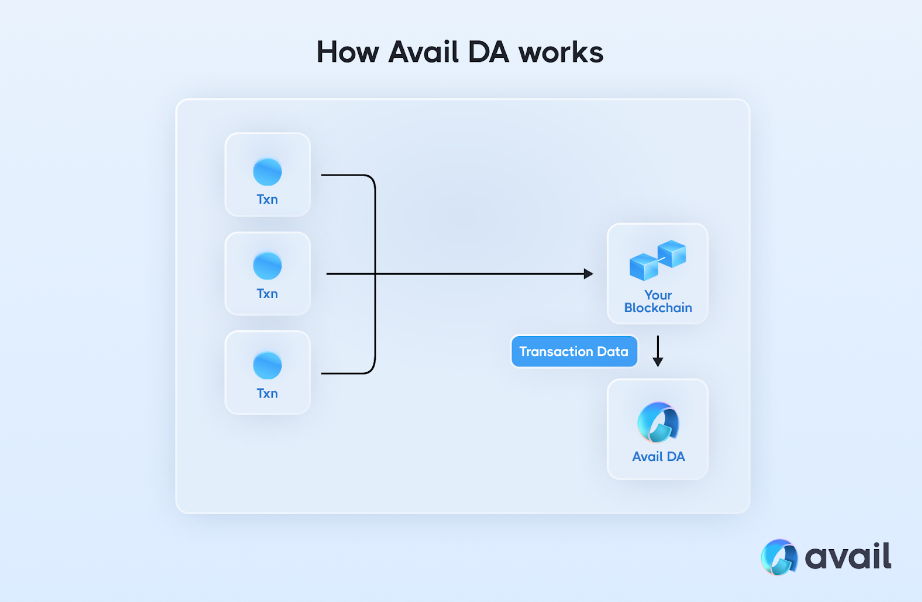Avail is a data availability blockchain engineered to unify Web3 ecosystems by enhancing scalability, interoperability, and security across the blockchain landscape. Its primary aim is to address the inherent limitations of traditional blockchain platforms. Avail achieves this by providing a flexible platform that can be customized to meet the specific needs of various applications. As a foundational layer, Avail enables developers to build additional blockchain solutions on top of it, offering a secure and scalable data availability layer along with a customizable consensus layer tailored to diverse application requirements.
About the Project
Vision
The Avail ecosystem aims to be a unifying force in the rollup-centric world. This goal is pursued by creating cohesive experiences, enabling seamless interactions across different chains, aggregating cryptographic proofs across ecosystems, or integrating shared security guarantees across various value layers.
Problem
A key challenge in Web3 is data availability. In decentralized applications (dApps), it’s essential to ensure all transaction data is accessible and verifiable. Traditional blockchain architectures often struggle to scale data availability as transaction volumes grow, leading to bottlenecks and reduced performance. Nodes must store large amounts of data, often requiring hardware upgrades, which can limit accessibility. Interoperability between blockchain networks is another significant issue. The fragmented Web3 landscape, with many isolated blockchains, creates challenges for users and developers navigating between them.The current fragmentation and complex cross-ecosystem transactions hinder broader adoption, making it crucial to focus on onboarding new users rather than shifting them between existing communities.
Solution

Avail is designed to unify the fragmented Web3 ecosystem by providing a cohesive platform that integrates diverse blockchain technologies while preserving decentralization. Its mission is to enhance scalability, interoperability, and security across the Web3 landscape, utilizing a modular technology stack comprised of three core layers:
Avail DA
Avail DA serves as a foundational data availability layer, providing a scalable and shared source of truth for blockchain networks by ensuring all data is accessible, and nothing is concealed. It addresses blockchain scalability by offering ample data availability blob space, crucial for scaling rollups and blockchains. This capability supports advanced technologies such as validity proofs and data availability sampling and is compatible with significant rollup stacks and non-EVM execution environments.
Avail Fusion
Avail Fusion strengthens the security of the Avail ecosystem by incorporating native assets from established ecosystems like BTC and ETH, along with new rollup tokens, into its consensus mechanism. Through multi-asset staking, Fusion secures the infrastructure of Avail’s Unification Layer. Stakers receive AVAIL as rewards while contributing additional security through their holdings of well-established crypto assets, such as BTC and ETH. This integrated approach ensures a robust and secure foundation for Avail’s operations.
Avail Nexus
Avail Nexus is a ZK coordination rollup that functions as a verification hub, unifying rollups and facilitating seamless communication between them by using Avail DA as the root of trust. Serving as the interoperability component, Avail Nexus processes cross-chain transactions, allowing users to access multiple blockchains without the need for manual bridging. Built on top of Avail DA, Avail Nexus integrates directly into user applications, enabling efficient and secure cross-ecosystem interactions.
Features
- Modular Architecture: Avail features a modular design with separate components that can be easily swapped or updated. This modularity enhances the blockchain’s flexibility, allowing it to adapt to new developments. Developers can select components that best fit their needs and customize the blockchain to meet their requirements.
- Data Availability Layer: The data availability layer plays a crucial role in recording and maintaining data on the blockchain. It is designed for exceptional scalability and efficiency, handling large volumes of transactions with ease. Its primary function is to ensure that all data from completed transactions is accurately recorded and readily accessible.
- Scalability: Avail is built to excel in scalability, efficiently supporting many users and transactions. The blockchain’s design incorporates advanced strategies, such as sharding and a proof-of-stake consensus mechanism, enabling it to manage significant transaction volumes without sacrificing performance.
- Security and Privacy: Security and privacy are central to Avail’s design. The platform ensures the safety and reliability of user data and transactions through a comprehensive strategy that includes cryptography, decentralization, and controlled access. These measures guarantee that sensitive information remains confidential and accessible only to authorized individuals. Avail also supports private transactions, allowing users to maintain the privacy of their data.
- Interoperability: Avail promotes interoperability by offering tools and protocols that enable seamless communication between different blockchain networks and systems. This allows for cross-chain transactions and data sharing, enhancing connectivity across the broader blockchain ecosystem.
Market Analysis
Blockchain technology has seen extraordinary growth since its inception. The market is currently valued at $2.6 trillion, and projections indicate sustained expansion in the coming years. This rapid growth highlights the increasing importance of blockchain in various industries and the potential for further innovation.
At the forefront of this evolution are modular blockchains, emerging as the future of blockchain technology. Unlike traditional monolithic blockchains, where all functions—such as data availability, consensus, and execution—are integrated into a single layer, modular blockchains separate these essential components into distinct, specialized layers. This architectural separation allows each layer to focus on optimizing its specific function, enhancing overall scalability, flexibility, and efficiency.
By enabling each layer to operate independently and interact with others only as needed, modular blockchains overcome many of the limitations faced by monolithic systems. As the blockchain ecosystem continues to evolve, modular blockchains are expected to play a pivotal role in shaping the technology’s future, offering more robust, scalable, and adaptable solutions to the digital economy’s complex needs. These systems are poised to unlock new possibilities for decentralized applications and cross-chain connectivity by resolving issues like data availability and enhancing the overall user experience.
Competitors
Celestia: Celestia is a modular blockchain network designed to provide consensus and data availability services to other blockchains, with a strong emphasis on security, decentralization, and scalability. By separating the consensus and application execution layers, Celestia ensures data security while simplifying application development. In contrast, Avail operates as a dedicated data availability layer specifically designed to enhance the security and scalability of other blockchain networks.
EigenDA: EigenDA is a protocol that offers an efficient and cost-effective solution for rollups to package and transmit their transaction data to Ethereum’s consensus layer, where validators require it to verify blocks containing the rollups’ commitments. Essentially, it functions as a high-throughput data availability (DA) service for rollups. EigenDA is built on top of EigenLayer, an Ethereum restaking protocol that allows developers to leverage Ethereum’s validator set and economic security, eliminating the need to bootstrap their own decentralized network. The same team behind EigenLayer leads the development of EigenDA.
NEAR DA: NEAR DA is poised to launch with a range of initial users, including projects such as Madara by StarkNet, Caldera, Fluent, Vistara, Dymension RollApps, and Movement Labs. NEAR DA aims to help developers reduce costs and improve their rollups’ reliability while maintaining Ethereum’s security. High-quality projects launching an app chain or Layer 2 (L2) will also benefit from NEAR DA support. NEAR DA is developed by the Near Foundation, the organization behind the NEAR Protocol. This initiative is set to further solidify NEAR’s position as a leading force in blockchain innovation.

Traction
Last month marked the successful launch of the Avail mainnet, a significant milestone for the project. Before this achievement, Avail secured over 70 strategic partnerships, including collaborations with the five largest Layer-2 (L2) ecosystems, positioning itself as a critical player in the blockchain space. This extensive network of partnerships ensures that Avail’s Data Availability (DA) solution is readily accessible to developers on leading platforms such as Arbitrum, Optimism, Polygon, Starkware, and ZKsync.
The Goldberg Testnet demonstrated Avail’s robust capabilities, with over 87,000 accounts contributing to the testing process and processing more than 118 million transactions. During this phase, Avail DA successfully facilitated data submissions totaling 140 GB, effectively meeting the data demands of nearly all L2 networks for 2023. These impressive figures highlight the widespread adoption and reliability of Avail’s technology, setting a strong foundation for future growth. In addition to its technical achievements, Avail has cultivated a vibrant and engaged community. Avail has established a substantial online presence with over 300,000 followers on X (formerly Twitter) and more than 200,000 members on Discord. This active community reflects the project’s growing influence and the strong support it has garnered within the blockchain ecosystem.
As Avail continues to expand its reach and solidify its position in the market, these accomplishments signal a promising future for the platform and its community of developers and users.
| Fundamental Analysis | |||||
| Assessment | |||||
| Problem | Significant, long-term problem | 3 | |||
| Solution | Distinct, defensible solution | 3 | |||
| Market Size | Large market, significant growth potential | 3 | |||
| Competitors | Emerging market with few strong competitors | 3 | |||
| Unique Value Proposition | Clear differentiation and value for customers | 3 | |||
| Current Traction | Solid traction, user engagement and retention growing | 3 | |||
| Unit Economics | Break-even or slightly positive unit economics | 2 | |||
| Tokenomics | Solid token strategy, aligns with user incentives | 3 | |||
| Product Roadmap | Unclear or unrealistic product roadmap | 1 | |||
| Business Model | Proven business model with clear path to profitability | 3 | |||
| Go-to-Market Strategy | Highly effective GTM strategy, innovative and well-differentiated | 4 | |||
| Regulatory Risks | Minimal regulatory risk, strong mitigation and adaptability | 4 | |||
| Total | 72.92% | ||||





